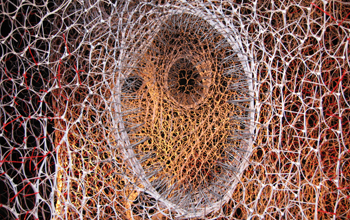Multimedia Gallery
"Branching Morphogenesis"
"Branching Morphogenesis," by Peter Lloyd Jones, biologist, and architect Jenny E. Sabin, University of Pennsylvania's Sabin+Jones LabStudio.
Forget about staring at data on a computer screen; try walking through those statistics and touching them. With this illustration of the forces lung cells exert as they form capillaries, scientists and museum-goers can do just that. The 3.5 meter-tall, 3-D art installation is one of several projects by Jones and Sabin that depict large, complex datasets in new ways. "Sometimes graphing data won't tell you about its intricacies," Jones says. "This makes the whole process exciting and interactive."
The sculpture depicts five snapshots from a computer simulation of lung endothelial cells pushing against and pulling on the protein matrix that surrounds them. Using the simulation data as a template, the team connected 75,000 cable zip ties, each representing a single data point, into five, 4.5 meter-wide hanging curtains for each time point. The designers built zip-tie tunnels between the curtains, so viewers could peer through them and watch how the cells' forces changed over time.
This image won First Place in the Illustration category of the 2009 International Science & Engineering Visualization Challenge (SciVis) competition, sponsored by the National Science Foundation and the journal Science. The competition is held each year to celebrate the grand tradition of science visualization and to encourage its continued growth. The spirit of the competition is to communicate science, engineering and technology for education and journalistic purposes. To learn more about the competition and view all the winning entries, see the NSF SciVis Special Report. (Date of Image: August 2008)
Credit: Jenny E. Sabin (lead designer), Peter Lloyd Jones (lead scientist), Andrew Lucia and Annette Fierro; Sabin+Jones LabStudio, University of Pennsylvania
See other images like this on your iPhone or iPad download NSF Science Zone on the Apple App Store.
Images and other media in the National Science Foundation Multimedia Gallery are available for use in print and electronic material by NSF employees, members of the media, university staff, teachers and the general public. All media in the gallery are intended for personal, educational and nonprofit/non-commercial use only.
Images credited to the National Science Foundation, a federal agency, are in the public domain. The images were created by employees of the United States Government as part of their official duties or prepared by contractors as "works for hire" for NSF. You may freely use NSF-credited images and, at your discretion, credit NSF with a "Courtesy: National Science Foundation" notation.
Additional information about general usage can be found in Conditions.
Also Available:
Download the high-resolution JPG version of the image. (9.9 MB)
Use your mouse to right-click (Mac users may need to Ctrl-click) the link above and choose the option that will save the file or target to your computer.

